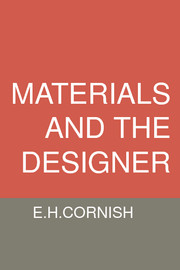Book contents
- Frontmatter
- Contents
- Preface
- Introduction
- 1 The impact of design on manufacturing industry
- 2 Expertise required for the design process
- 3 An introduction to materials
- 4 Properties of metals and alloys
- 5 Properties of ceramics
- 6 Properties of polymers
- 7 Properties of composites
- 8 Materials' performance in service
- 9 Finishes and coatings as protective systems
- 10 Materials reliability and service life
- 11 Factors controlling the selection of substitute materials
- 12 Material forming processes and design
- 13 Sources of information on materials
- 14 Standards and materials
- References
- Bibliography
- Index
7 - Properties of composites
Published online by Cambridge University Press: 05 August 2012
- Frontmatter
- Contents
- Preface
- Introduction
- 1 The impact of design on manufacturing industry
- 2 Expertise required for the design process
- 3 An introduction to materials
- 4 Properties of metals and alloys
- 5 Properties of ceramics
- 6 Properties of polymers
- 7 Properties of composites
- 8 Materials' performance in service
- 9 Finishes and coatings as protective systems
- 10 Materials reliability and service life
- 11 Factors controlling the selection of substitute materials
- 12 Material forming processes and design
- 13 Sources of information on materials
- 14 Standards and materials
- References
- Bibliography
- Index
Summary
As with ceramics, the designer will often be forced to work with composites by designing an object which has to be made by an outside specialist. He will seldom be in a position to purchase ready-made stock shapes from which his brainchild can be fabricated. Accordingly, much of this chapter will be devoted to showing the designer a general view of composites as a class of materials so that he will be able to pose the correct questions to his advisers and suppliers, and perhaps even to understand their answers.
Definition of composite types
The term ‘composite’ covers a very wide variety of forms. Thus a concrete path can be considered a composite, as may a printed circuit board used in a television set. However, for the purposes of the present discussion, emphasis will be placed on composite materials to be used in engineering but not in building or electronics. Composite constructions can also readily be dismissed. Thus, for example, a sheet of plastic covered with a metal film for decorative or strength purposes, or a concrete – steel composite floor used in a building, should really be thought of as composite structures and not composite materials. By the latter we mean essentially a material in which there is a continuous phase, usually representing the greater proportion of the whole by weight or volume, containing dispersed discrete islands of a second phase.
- Type
- Chapter
- Information
- Materials and the Designer , pp. 124 - 142Publisher: Cambridge University PressPrint publication year: 1987



